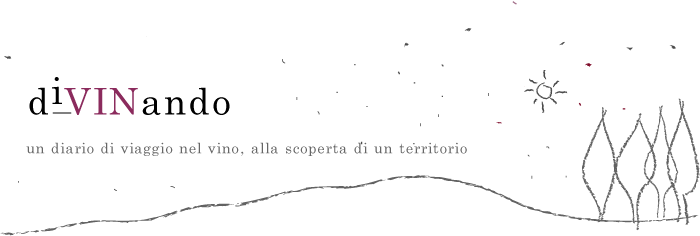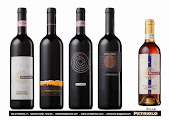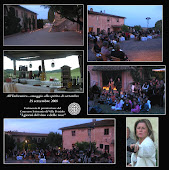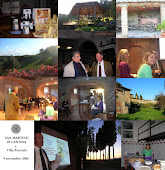 _Tenuta di Fessina_
Etna, Dangerous Beauty. By Lorenzo Ruggeri (INTERNATIONAL TRE BICCHIERI, July 2013):
_Tenuta di Fessina_
Etna, Dangerous Beauty. By Lorenzo Ruggeri (INTERNATIONAL TRE BICCHIERI, July 2013):
“On June 21, 2013, while the news agencies transmitted the news that Mount Etna had become one of the UNESCO World Heritage sites, the volcano (
a’ Muntagna, as it’s called locally in dialect – the Mountain) tranquilly smoked. Seen from the base, from the sea, really, the largest active volcano in Europe shone in all its dangerous beauty, exerting that magnetic fatal attraction, inspiring a mix of admiration and awe. Etna bestows fertile land and magnificent scenery, but it can be cruel and violent, carrying away in a few days houses, fields and the belongings of entire villages. People have learned to deal with this 3,000 meter tall giant (3,340 meters to be precise). Between one lava flow and another, the Parco dell’Etna is home to a patrimony of old grapevines of inestimable value. Viticulture extends to an altitude of 1,400 meters, a European record. On the slopes, overlooking the sea, are plots of land separated by dry lava stone walls, alberello-trained vines and instances of rare pre-phylloxera vineyards. It is a marvelous and multi-hued territory with widely varied exposures and vegetation, a microclimate that defies all Sicily’s supposed meteorological certainties. Etna is a north in the south, with cool, breezy summers, temperature excursions between night and day that can amount to 25°C (77° Fahrenheit), and rainfall double that of eastern Sicily.

The vineyards, like other crops, sink their roots into sandy soil, rich in minerals. The black lava powder emitted by the volcano (ripiddu in dialect) periodically dusts roads and fields, as it has in recent weeks. But everything that grows here seems to have a special flavor: premium pistachios from Bronte, aromatic honey from Zafferena Etnea, the delicious strawberries of Maletto, fragrant flat peaches (doughnut or Saturn in English, tabacchiera in Italian), black pigs from the Nebrodi mountains. But nothing manages to capture the soul of this place like its wines. They are uniquely fascinating, Mediterranean and sunny, but also remarkably delicate in their aromas. Their subtle balance and unusual minerality is unlike the usual weightiness of other Sicilian reds and whites. They are also fragile wines, as if the fatality of the volcano expressed itself in the glass. A delicately smoky note, pencil lead tone and marked minerality in both reds and whites are unmistakable characteristics. By 1700, the Etna vineyards that faced the sea and the mainland of Calabria were famous for the production of an excellent wine that left nearby ports for distant destinations. The logic of the cru was established early, and for this reason, comparisons with Piedmont and Burgundy abound. Nerello (literally ‘little black one’) mascalese and cappuccio, with its characteristic pale color and its relaxed but energetic palate, are the principal Etna Rosso stars. Carricante is the voice of Etna Bianco. And then there’s the irresistible charm of some Etna Rosato, also made with nerello mascalese grapes in a consistently artisanal manner. Over the last fifteen years, the wine of Etna has undergone a revolution in terms of quality, new producers and commercial value. Consider the increased cost of land. In 2002, a hectare in the zone cost 12,000 euros. Today it has reached 80,000 euros. Among the most important figures on the scene is Salvo Foti, producer, enologist and a renowned promoter of the potential of this terroir. We hope that recognition on the part of UNESCO contributes to spotlighting the Parco dell’Etna and aids its conservation, both natural and architectural. From the point of view of tourism, all the elements are in place for a new boom.The zone is twenty minutes from Taormina, with its Greek theater and glamorous beaches, an hour by car (plus ferry) from other beautiful volcanic formations – the Aeolian islands – and from marvelous cities such as Catania and Siracusa. But above all, the zone has its wines, a heritage belonging to all fans of fine drinking”.


 _Tenuta di Fessina_
Etna, Dangerous Beauty. By Lorenzo Ruggeri (INTERNATIONAL TRE BICCHIERI, July 2013):
“On June 21, 2013, while the news agencies transmitted the news that Mount Etna had become one of the UNESCO World Heritage sites, the volcano (a’ Muntagna, as it’s called locally in dialect – the Mountain) tranquilly smoked. Seen from the base, from the sea, really, the largest active volcano in Europe shone in all its dangerous beauty, exerting that magnetic fatal attraction, inspiring a mix of admiration and awe. Etna bestows fertile land and magnificent scenery, but it can be cruel and violent, carrying away in a few days houses, fields and the belongings of entire villages. People have learned to deal with this 3,000 meter tall giant (3,340 meters to be precise). Between one lava flow and another, the Parco dell’Etna is home to a patrimony of old grapevines of inestimable value. Viticulture extends to an altitude of 1,400 meters, a European record. On the slopes, overlooking the sea, are plots of land separated by dry lava stone walls, alberello-trained vines and instances of rare pre-phylloxera vineyards. It is a marvelous and multi-hued territory with widely varied exposures and vegetation, a microclimate that defies all Sicily’s supposed meteorological certainties. Etna is a north in the south, with cool, breezy summers, temperature excursions between night and day that can amount to 25°C (77° Fahrenheit), and rainfall double that of eastern Sicily.
_Tenuta di Fessina_
Etna, Dangerous Beauty. By Lorenzo Ruggeri (INTERNATIONAL TRE BICCHIERI, July 2013):
“On June 21, 2013, while the news agencies transmitted the news that Mount Etna had become one of the UNESCO World Heritage sites, the volcano (a’ Muntagna, as it’s called locally in dialect – the Mountain) tranquilly smoked. Seen from the base, from the sea, really, the largest active volcano in Europe shone in all its dangerous beauty, exerting that magnetic fatal attraction, inspiring a mix of admiration and awe. Etna bestows fertile land and magnificent scenery, but it can be cruel and violent, carrying away in a few days houses, fields and the belongings of entire villages. People have learned to deal with this 3,000 meter tall giant (3,340 meters to be precise). Between one lava flow and another, the Parco dell’Etna is home to a patrimony of old grapevines of inestimable value. Viticulture extends to an altitude of 1,400 meters, a European record. On the slopes, overlooking the sea, are plots of land separated by dry lava stone walls, alberello-trained vines and instances of rare pre-phylloxera vineyards. It is a marvelous and multi-hued territory with widely varied exposures and vegetation, a microclimate that defies all Sicily’s supposed meteorological certainties. Etna is a north in the south, with cool, breezy summers, temperature excursions between night and day that can amount to 25°C (77° Fahrenheit), and rainfall double that of eastern Sicily.
 The vineyards, like other crops, sink their roots into sandy soil, rich in minerals. The black lava powder emitted by the volcano (ripiddu in dialect) periodically dusts roads and fields, as it has in recent weeks. But everything that grows here seems to have a special flavor: premium pistachios from Bronte, aromatic honey from Zafferena Etnea, the delicious strawberries of Maletto, fragrant flat peaches (doughnut or Saturn in English, tabacchiera in Italian), black pigs from the Nebrodi mountains. But nothing manages to capture the soul of this place like its wines. They are uniquely fascinating, Mediterranean and sunny, but also remarkably delicate in their aromas. Their subtle balance and unusual minerality is unlike the usual weightiness of other Sicilian reds and whites. They are also fragile wines, as if the fatality of the volcano expressed itself in the glass. A delicately smoky note, pencil lead tone and marked minerality in both reds and whites are unmistakable characteristics. By 1700, the Etna vineyards that faced the sea and the mainland of Calabria were famous for the production of an excellent wine that left nearby ports for distant destinations. The logic of the cru was established early, and for this reason, comparisons with Piedmont and Burgundy abound. Nerello (literally ‘little black one’) mascalese and cappuccio, with its characteristic pale color and its relaxed but energetic palate, are the principal Etna Rosso stars. Carricante is the voice of Etna Bianco. And then there’s the irresistible charm of some Etna Rosato, also made with nerello mascalese grapes in a consistently artisanal manner. Over the last fifteen years, the wine of Etna has undergone a revolution in terms of quality, new producers and commercial value. Consider the increased cost of land. In 2002, a hectare in the zone cost 12,000 euros. Today it has reached 80,000 euros. Among the most important figures on the scene is Salvo Foti, producer, enologist and a renowned promoter of the potential of this terroir. We hope that recognition on the part of UNESCO contributes to spotlighting the Parco dell’Etna and aids its conservation, both natural and architectural. From the point of view of tourism, all the elements are in place for a new boom.The zone is twenty minutes from Taormina, with its Greek theater and glamorous beaches, an hour by car (plus ferry) from other beautiful volcanic formations – the Aeolian islands – and from marvelous cities such as Catania and Siracusa. But above all, the zone has its wines, a heritage belonging to all fans of fine drinking”.
The vineyards, like other crops, sink their roots into sandy soil, rich in minerals. The black lava powder emitted by the volcano (ripiddu in dialect) periodically dusts roads and fields, as it has in recent weeks. But everything that grows here seems to have a special flavor: premium pistachios from Bronte, aromatic honey from Zafferena Etnea, the delicious strawberries of Maletto, fragrant flat peaches (doughnut or Saturn in English, tabacchiera in Italian), black pigs from the Nebrodi mountains. But nothing manages to capture the soul of this place like its wines. They are uniquely fascinating, Mediterranean and sunny, but also remarkably delicate in their aromas. Their subtle balance and unusual minerality is unlike the usual weightiness of other Sicilian reds and whites. They are also fragile wines, as if the fatality of the volcano expressed itself in the glass. A delicately smoky note, pencil lead tone and marked minerality in both reds and whites are unmistakable characteristics. By 1700, the Etna vineyards that faced the sea and the mainland of Calabria were famous for the production of an excellent wine that left nearby ports for distant destinations. The logic of the cru was established early, and for this reason, comparisons with Piedmont and Burgundy abound. Nerello (literally ‘little black one’) mascalese and cappuccio, with its characteristic pale color and its relaxed but energetic palate, are the principal Etna Rosso stars. Carricante is the voice of Etna Bianco. And then there’s the irresistible charm of some Etna Rosato, also made with nerello mascalese grapes in a consistently artisanal manner. Over the last fifteen years, the wine of Etna has undergone a revolution in terms of quality, new producers and commercial value. Consider the increased cost of land. In 2002, a hectare in the zone cost 12,000 euros. Today it has reached 80,000 euros. Among the most important figures on the scene is Salvo Foti, producer, enologist and a renowned promoter of the potential of this terroir. We hope that recognition on the part of UNESCO contributes to spotlighting the Parco dell’Etna and aids its conservation, both natural and architectural. From the point of view of tourism, all the elements are in place for a new boom.The zone is twenty minutes from Taormina, with its Greek theater and glamorous beaches, an hour by car (plus ferry) from other beautiful volcanic formations – the Aeolian islands – and from marvelous cities such as Catania and Siracusa. But above all, the zone has its wines, a heritage belonging to all fans of fine drinking”.































Nessun commento:
Posta un commento